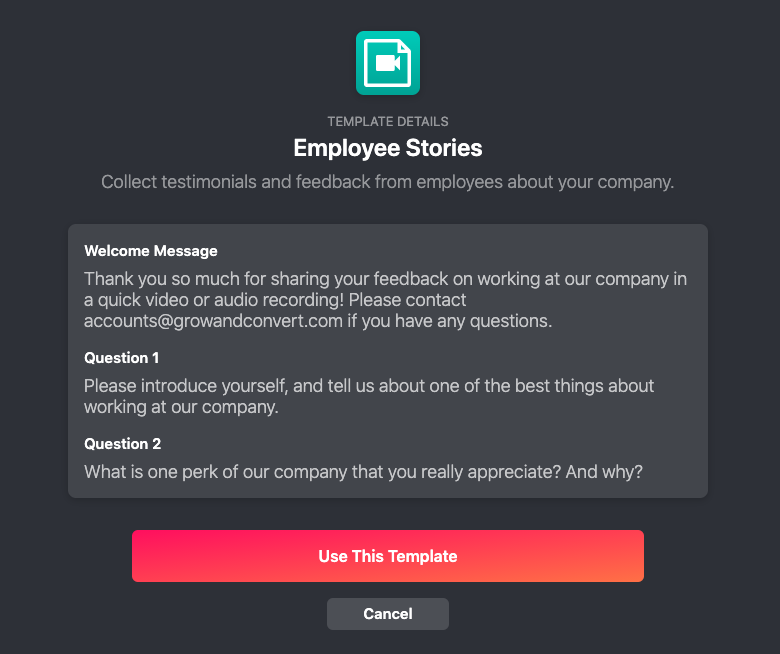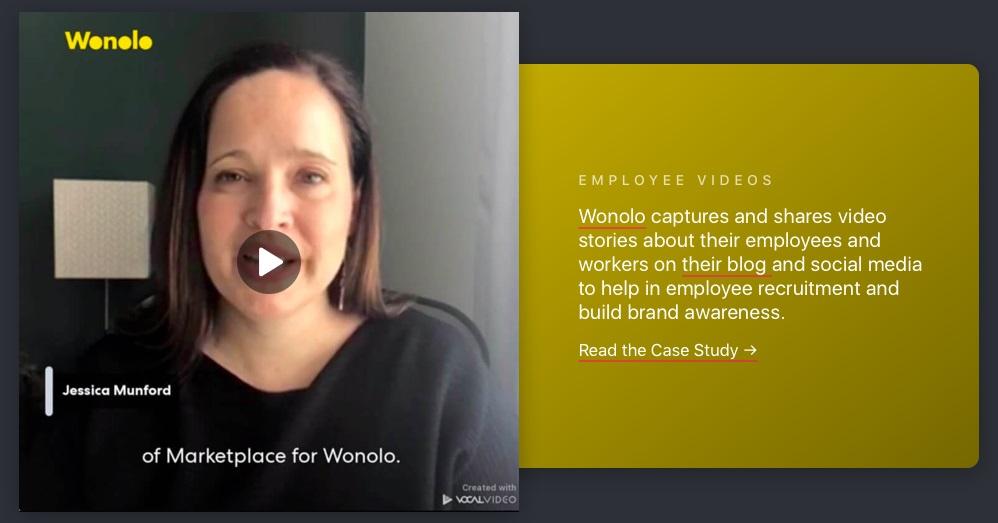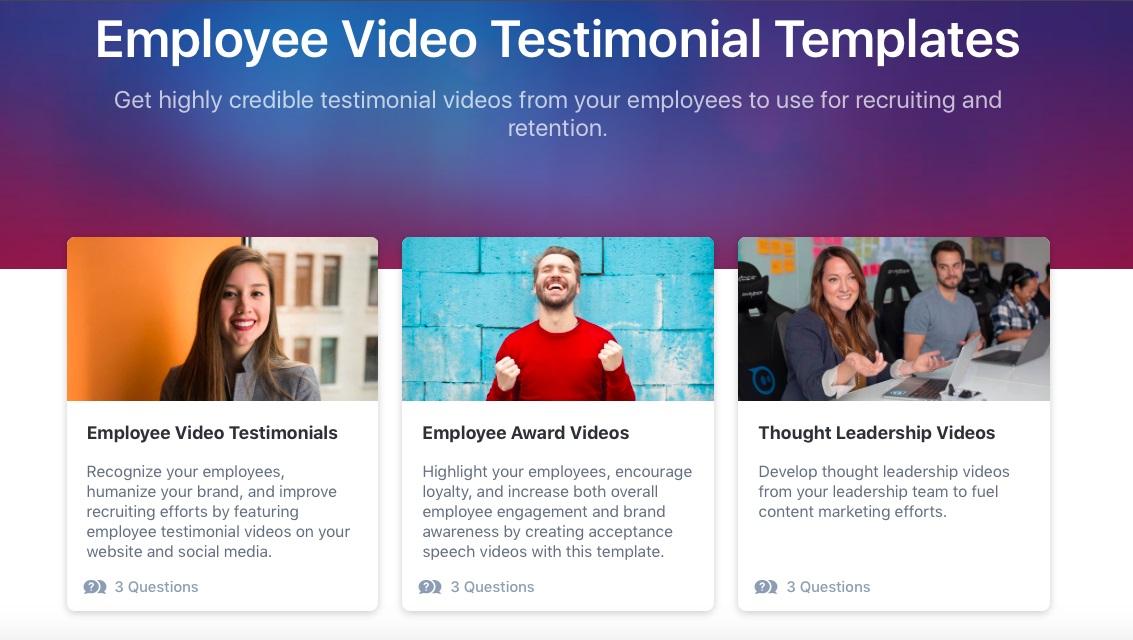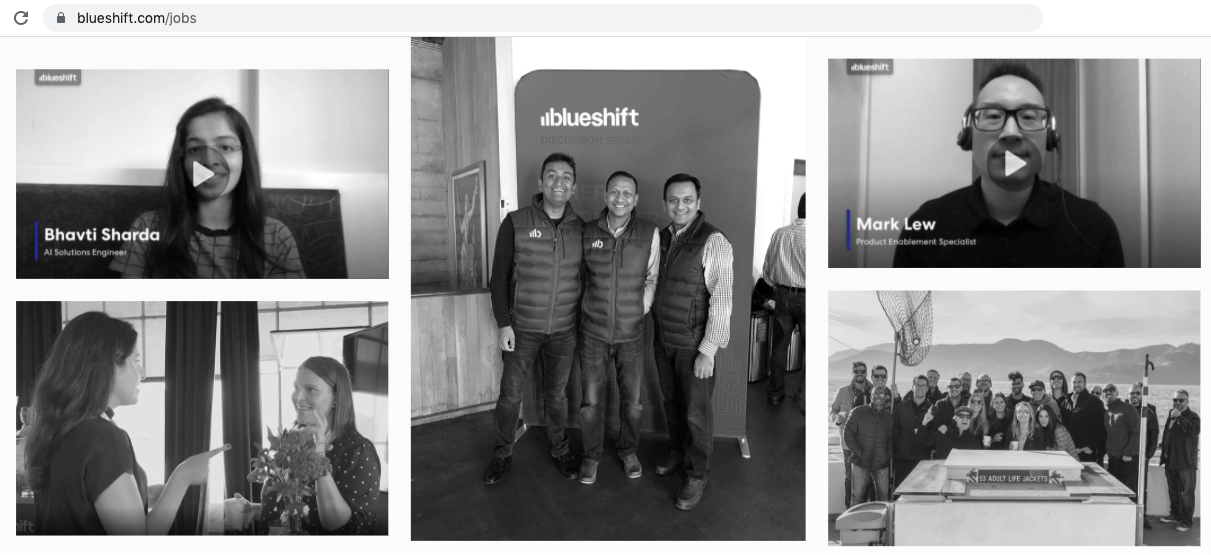Most resources about employee testimonials give you a long list of 25 questions and suggest you pick a few seemingly at random.
In our experience of over a decade of creating video testimonials, we’ve found you only need to ask three questions to create powerful testimonials. The key is to ask the right questions that will draw out plenty of valuable qualitative information from your interviewees.
Asking fewer questions means that the employee can answer each question in detail, making them more likely to provide compelling information that you can use for effective promotions across your employee, HR, and marketing campaigns. This is great for your employer branding, and staff retention, and will attract job seekers and new customers, too.
Below, we’ll expand on the three question themes which can be used in every scenario — two which set the scene and a third which crucially draws valuable qualitative information from your interviewees. Then, we’ll talk about how you can modify them to suit your needs and show you an example from a customer who did just that.
Finally, we’ll show how you can use pre-built templates and lists of questions within Vocal Video to collect employee testimonials quickly and easily.
It’s worth noting that we’ll be focusing on video testimonials in this post, but the same advice around employee testimonial questions also applies to written employee testimonials.
Note: Vocal Video helps you collect high-quality video testimonials asynchronously without special equipment or editing software. Learn more about how Vocal Video works here, or sign up for a free trial to test it out. No credit card is required, and you can get up and running in 15 minutes or less.
Why You Don’t Need to Ask Loads of Questions
The point of employee testimonials is to recruit future employees and make your company look good to existing and potential customers. This is important to keep in mind as you develop your questions.
Here we’ll expand on why you don’t need to ask loads of questions in order to do that.
Keep Questions Short and Sweet
When we say to keep it “short and sweet,” we mean “think about your audience and their time and effort.”
This includes the length of each question as well the number of questions used.
Each question should be short and simple, without too much text or too many answers to provide, so that participants don’t get overwhelmed.
This keeps your interviewees engaged because they don’t have a long list of questions to respond to all at once, which might be easy to forget.
A solid rule of thumb is to keep each question to one short sentence.
![Sample questions: How did you find your way to your current role at [organization name]? Could you share a few details about the favorite part of your role and the team at [organization name]? What stands out to you about the culture at [organization name]?](https://vocalvideo.com/resources/content/images/2021/07/employee-testimonial-questions-1.jpg)
Don’t Ask Too Many Questions
And, just because you’re keeping questions short doesn’t mean you should include a ton of them.
Keeping the list of questions short helps ensure participants actually answer them. Seeing a laundry list of questions can be overwhelming and off-putting for respondents and certainly won’t encourage good quality answers, or worse, no answers at all.
Generally, we suggest using between one and three questions, with an absolute maximum of five questions.
Here’s one example of a short, two-question survey that would be great for employee testimonial video collection:

The Key Questions You Need to Ask and Why It’s All About Qualitative Feedback
We’ve used our experience to identify the three broad question areas you need to cover in your employee testimonials. These provide a basic framework for your testimonials but you don’t need to stick to them rigidly.
Below, we’ll show how to reframe them to suit your needs and show you an example from one of our customers.
Here are the three themes we include in our employee testimonial videos templates:
- An introduction
- A description of your role
- What stands out about this organization
Together, these areas will draw compelling information from your employees which will be personal, authentic, and of real value to your marketing team.
Now, we’ll look at them in more detail.
Setting the Scene
Questions one and two allow the respondent to set the scene for the all important third ‘qualitative’ question. By introducing themselves, providing their job title and describing their role, they will be giving the context and background to their personal story.
The answers to these introductory questions will resonate with anyone watching the video who might be in a similar position as they will know pretty quickly whether the video is going to be relevant to them or not.
These questions are the springboard from which the valuable qualitative information will be generated. We’ll get to that next.
The Qualitative Question(s)
The third, qualitative question is the most important. It’s the question that’s going to get you the feedback that you wouldn’t get from quantitative sources such as employee reviews on recruitment websites or employee surveys.
It’s great to have those star ratings and stats but the human connection and the personal stories are where the real value lies.
In our example (above), we’ve asked, “What stands out about this organization?”, but you can reframe it to suit your company (more on this later). It gives the employee the opportunity to talk about what’s special about your company and demonstrate why you would choose this company over and above another.
Employees will typically say something personal and specific to them. For example, it could be something along the lines of, “I love working at ACME Inc because everyone is supportive and it feels like I’m surrounded by friends. I used to hate Mondays, but now I look forward to them!”
This kind of story speaks volumes about the company’s ethos — far more than a standalone Glassdoor rating or “best place to work” award. It gives an individual and emotional connection directly from an employee.
This sort of positive feedback provides great sales enablement for your recruiters, solid social proof when shown on your website or on social media, and gives everyone a positive impression of your organization.
These question areas are the foundation for your employee testimonials. However, no two companies will want to ask the exact same questions, and they don’t have to.
Note: See all 11 employee video testimonial templates and learn how to use them in our template library.
How to Adapt Those Questions to Your Use Case
It’s really easy to adapt the questions to suit you. Here’s how:
Think Backward from Your Goal
The best way to ask the perfect questions is to start by asking yourself what you want from the employee testimonial.
An easy way to figure this out is to ask, “If I were to get the perfect response from this respondent, what would they say?”
When you know the answer, try to work backward to the questions that will elicit that response.
Thinking backward in this manner will help you focus on what would be the most powerful employee testimonial quote to put on your website and then construct the question that will help you get that testimonial from a participant.
This goal can be as simple as, “We want employees to say they love the flexible working style at Vocal Video”, so you could ask, “How does the flexible working style at Vocal Video make your life better?”
Or, you might want an employee to talk about the fun working culture at your company. So, you could ask, “How would you describe the culture at [company]?” This could give you a great response which you could use as a clip on the testimonial page of your website.
Don’t Overthink It
Because these questions should be short and there shouldn’t be too many of them, it’s easy to get analysis paralysis worrying about making them perfect.
However, you’ll find that the bread-and-butter questions that are the most straightforward really do perform well when it comes to getting web-ready content from interviewees.
Go with the most obvious questions, and you’ll be surprised at the responses you receive.
Part of the benefit of using a tool like Vocal Video is that you get to collect many testimonials easily and quickly.
If you ask a question that isn’t quite getting the responses you want, you can just adjust the question or create a completely new “collector” (more on this below) before sending the interview out to your next batch of interviewees.
Finally, the great thing about humans and video is that even with the same questions, each response will be unique. Similar themes that emerge in your video responses can be woven together very effectively with highlight reels.
Here’s a summary for creating your own qualitative questions:
- Work backward from your desired outcome.
- Think about your culture and work backward from that.
- Figure out what you want people to emphasize.
- In general, keep it short and sweet — just to 2-3 questions.
- Ask open-ended questions.
- Don't overthink it.
How Wonolo Tailored the Questions
Now, we’ve set out how to reverse engineer questions to suit, here’s an example of a Vocal Video customer who did just that.
Our customer Wonolo, an on-demand staffing marketplace, formed their own specific questions using our template. They were running an expanded campaign where they wanted employee case studies with in-depth interviews that could be featured as stand-alone posts on their blog.
So, they didn’t focus too much on the contextual side, but homed in on the qualitative angle for their testimonials. They wanted to draw out personal stories from real people, i.e. their staff, to portray to potential employees what it’s really like to work for Wonolo.
After a brief introduction, the following questions were asked:
- What events in your life have brought you to your current role?
- Who do you look up to and why do you look up to them?
- What is one of your favourite memories at Wonolo?
- If you really knew me, you’d know that…

You can see how these questions drew out some great qualitative feedback here.
The Wonolo employee mentions values, empowering people, and having an opportunity to be really involved with his new department — all positive attributes which will appeal to potential employees.
He adds some personal information about his family and immigrant background which promotes Wonolo as an inclusive company with strong values. He mentions light-hearted activities with co-workers which demonstrate that Wonolo has a fun work environment with great camaraderie between team members.
The overall impression from this testimonial is that Wonolo is an inclusive company with great values. It has opportunities for employees to feel empowered and to progress within the organization which offers a fun work environment to work in. Any potential employee looking for those kinds of attributes in a company watching this testimonial will be attracted to Wonolo as a prospective employer.
Wonolo has adjusted and added to our questions to draw out the kind of responses they want to attract new employees. It’s worth noting again that glowing employee testimonials provide the social proof to impress both existing customers and attract potential customers.
You can read more about how Wonolo uses Vocal Video to capture and share employee videos here.
11 Templates Specifically for Employees
Employee videos are such a big use case for our customers, we developed a library of 11 video testimonial templates designed specifically for employees.

These shortcut the process above by giving you a starting point for everything you need, including questions and email templates. Plus, they're already modified for 11 use cases:
- Employee Video Testimonials
- Employee Award Videos
- Thought Leadership Videos
- Executive Story Videos
- Tutorial Videos
- Company Culture Videos
- Employee Bio Videos
- Customer Success Story Videos
- Sales Success Story Videos
- New Hire Videos
- New Employee Welcome Videos
All you need to do is copy, paste, and tweak the questions to suit your needs. And you don't have to pick 5 questions out of a list of 50, just adjust what's already there.
Even better, you can choose to use them just as is and spin them up directly within Vocal Video, immediately making your task of creating employee testimonials a lot more straightforward.
To learn more about our templates, visit our templates page.
Here’s how Vocal Video works as a platform to collect and create employee testimonials:
How Vocal Video Works
Vocal Video makes it super easy to collect employee video testimonials. You simply pick one of our templates, modify it to your liking, and use the automated software to help your employees shoot testimonials in just a few minutes.
Most people can get up and running in less than 15 minutes.
 Blueshift embeds employee video testimonials on their careers page.
Blueshift embeds employee video testimonials on their careers page.Simply pick one of our suggested templates — we have 45 in total, 11 of which are designed specifically for employees — use the questions as they are, adjust them, or create your own from the ground up like Wonolo did in our earlier example.
Then, you can grab the suggested email copy, tweak it to your liking, paste it into your email or SMS provider and share the link with the employees you’d like to get testimonials from.
Once your employees click on the link, they’re taken directly to the Vocal Video platform to record their review.
They don’t need to download anything, sign up for an account, or install anything to record the video. They can access the platform on any device, making the whole process smooth, which increases your chances of receiving quality responses.
Then, the collector walks interviewees through the process of creating the video, and asks them the questions you chose or created one by one. This reduces any potential anxiety for the interviewee and, from your point of view, keeps their answers on topic and relevant to your marketing needs.
Vocal Video automatically records each of the responses, although interviewees are given a chance to review and re-record if they don’t like what they see.
Once the responses have been recorded, Vocal Video automatically inserts them into your pre-prepared screens and overlays with your logo and branding colors, adds free music, and sends you an alert that a video review is ready for you to take a look at and edit further, if you want.
The whole process is simple and hassle free so you’re likely to get some great employee testimonials as a result.
Click here to sign up for a free Vocal Video account to start collecting video testimonials right away. You can collect unlimited videos and no credit card is required!